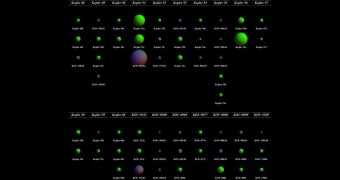Astronomers operating the NASA Kepler Telescope announce the discovery of 41 new exoplanetary candidates, in the latest datasets the planet-hunting space observatory relayed back to Earth. All of these objects are transiting worlds, the team says.
The existence of the 41 planets was verified in two new studies. The objects are scattered throughout 20 star systems, all of which are located inside Kepler's relatively-narrow field-of-view. The discovery may raise the number of exoplanets the telescope discovered thus far by more than 50 percent.
According to astronomers, the new numbers raise the total exoplanetary count to 116 worlds in 67 star systems. They say that more than half of these systems contain two or more extrasolar planets.
Details of the 41 new worlds are currently undergoing peer-review and will most likely appear in scientific journals soon. Interestingly, the two studies that confirmed their existence were conducted independent of each other, and on different targets.
Only 5 of the stars systems included in the two papers were surveyed by both studies. Experts revealed that these worlds range from one to seven Earth radii. However, the vast majority of the new exoplanets orbit extremely close to their parent stars, meaning that they cannot support life.
Kepler studied a measure called Transit Timing Variations (TTV) in order to discover these worlds. In populated star systems, planets exert a gravitational influence on their parent stars, but also among themselves. TTV data helps experts figure out how these interplays occur.
“These systems, with their large gravitational interactions, give us important clues about how planetary systems form and evolve. This information helps us understand how our own solar system fits into the population of all planetary systems,” Jason Steffen says.
The expert, who holds an appointment as a Brinson postdoctoral fellow at the Fermilab Center for Particle Astrophysics, in Batavia, Illinois, was the lead researcher on one of the two studies.
Both surveys used data from Kepler. The telescope constantly monitors the brightness levels of 150,000+ stars in its field-of-view, looking for dips in the amount of light it detects. If such dips occur periodically, it could imply that a planet is moving between its star and the telescope.
“The sheer volume of planet candidates being identified by Kepler is inspiring teams to look at the planet confirmation and characterization process differently,” Kepler mission scientist Natalie Batalha says. She is based at the NASA Ames Research Center (ARC) in Moffett Field, California.
“This TTV confirmation technique can be applied to large numbers of systems relatively quickly and with little or no follow-up observations from the ground. Perhaps the bottleneck between identifying planet candidates and confirming them just got a little wider,” she concludes.

 14 DAY TRIAL //
14 DAY TRIAL //